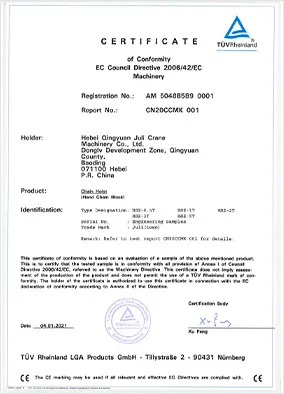


Understanding the Hand Chain Block A Vital Component in Hoisting Operations
In the realm of lifting and rigging equipment, the hand chain block stands out as an indispensable tool. Known for its robustness and reliability, this mechanical device plays a crucial role in various industrial applications, particularly in construction, mining, and manufacturing. Understanding the hand chain block’s design, operation, and benefits can aid professionals in making informed choices when it comes to lifting equipment.
A hand chain block, also referred to as a chain hoist, is designed to lift heavy loads by using a manual chain mechanism. The core components include the load chain, hand chain, gearbox, and the lifting hook. The load chain is the heavy-duty chain that attaches to the load, while the hand chain is the manual chain that the operator pulls to engage the lifting mechanism. When the hand chain is pulled, it turns a gearbox that translates the motion into vertical movement of the load chain, effectively raising or lowering the load attached to the lifting hook.
One of the defining features of hand chain blocks is their capacity. They come in various sizes, each capable of lifting different weight limits. Typically, one can find hand chain blocks that can lift anywhere from a few hundred kilograms to several tons. This versatility makes them suitable for a wide range of tasks, from hoisting small machinery to lifting heavy steel beams.
Safety is paramount in any lifting operation, and hand chain blocks are designed with various safety features. One essential component is the overload protection mechanism, which prevents the operator from accidentally lifting loads beyond the hoist’s rated capacity. Additionally, many models include a load limiter and a mechanically actuated brake system, ensuring that the load remains secure while being lifted and does not inadvertently drop.

Using a hand chain block is often more efficient in environments where electricity may not be readily available or where a power source would pose a safety risk. The simplicity of manual operation allows for flexibility and ease of use in varied work settings. Operators can quickly adapt the block to their surroundings, making it a favored choice for both indoor and outdoor applications.
Maintenance is another critical factor that extends the lifespan of a hand chain block. Regular inspections should include checking the load chain for wear and tear, lubricating moving parts, and ensuring that the brake system functions properly. Keeping the equipment in good condition not only enhances safety but also improves efficiency during operations.
In terms of cost-effectiveness, hand chain blocks represent a practical choice for transient work sites. Many industries often require lifting tools that can be quickly deployed and removed, making portable hand chain blocks invaluable. Their relatively lower purchase and maintenance costs compared to electric hoists also appeal to smaller businesses or projects with limited budgets.
In conclusion, the hand chain block is a vital lifting tool characterized by its reliable mechanics, operational flexibility, and safety features. Its manual operation is particularly beneficial in environments lacking power sources, making it suitable for diverse industrial applications. By understanding the mechanics, safety precautions, and maintenance requirements of hand chain blocks, both operators and managers can optimize lifting operations and enhance workplace safety. As lifting technology continues to evolve, hand chain blocks maintain their status as a tried-and-true solution in an ever-changing industrial landscape.



